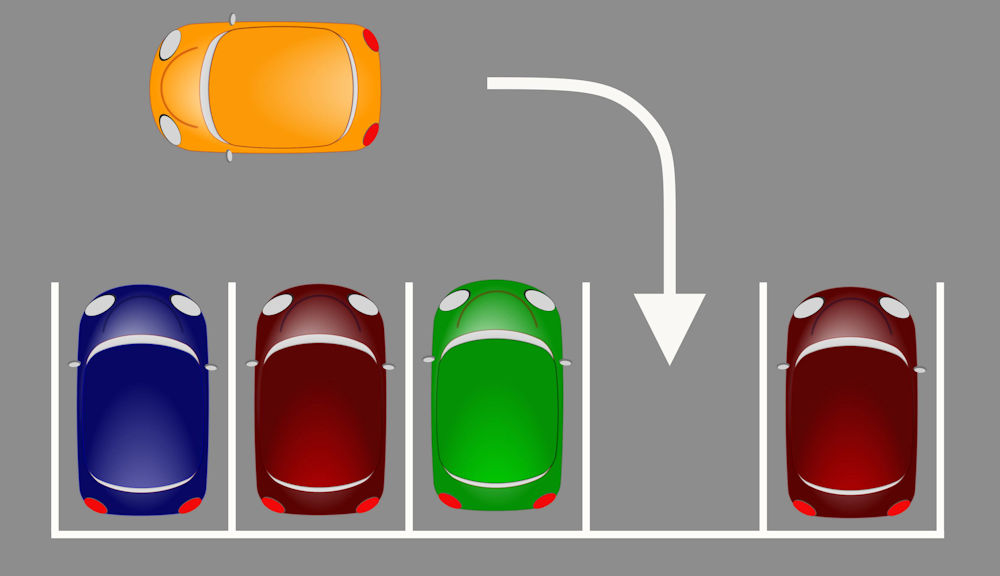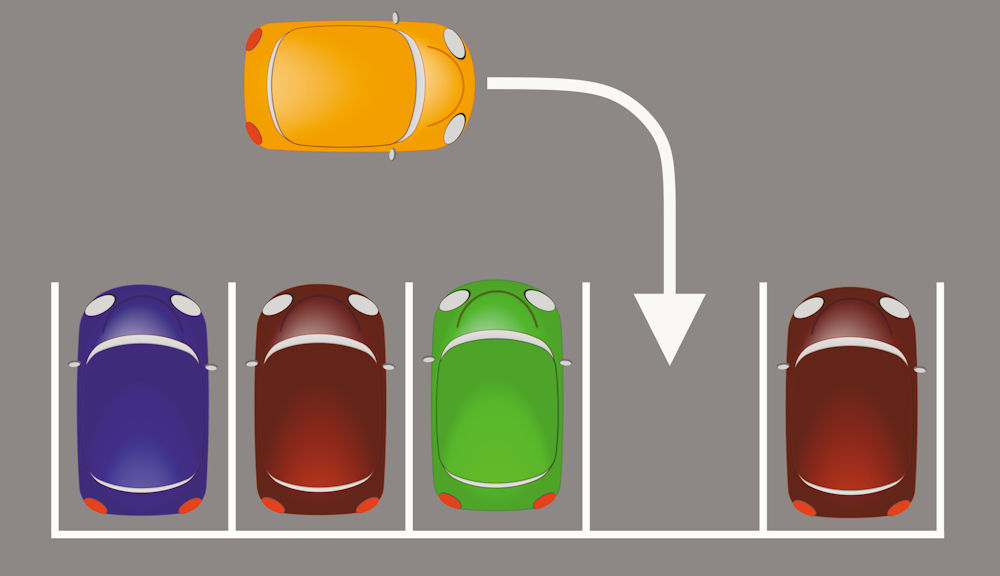
The original version of this dates back to 2011, and there are updates here, and here. This July 2018 edit reflects the new driving test, which came into force in December 2017.
The new test has done away with the Turn In The Road (aka “three-point turn”) and Reversing Into A Corner. These have been replaced with Forward Bay Parking and Stopping On The Right. The Reverse Bay Park and Parallel Park manoeuvres are still tested.
At the time of the original article, some test centres didn’t ask candidates to do a reverse bay park simply because they didn’t have a car park to do it in. It was no secret that in those areas a fair number of ADIs didn’t bother teaching it (virtually no one taught it in Nottingham before Colwick Test Centre opened – the first TC in Nottingham to have a car park big enough to do it).
Since December 2017, there are now two bay park manoeuvres – the original reverse one, and one which involves driving in forwards, then reversing out again. A reader informed me several months ago that the reverse park is always done at the TC, whereas the forward park can be done at various locations outside (supermarkets, council parks, etc.). I wasn’t aware of that, and had assumed that they could both be done anywhere.
Many drivers are terrified of any sort of parking and spend a large part of their driving lifetimes avoiding doing it. So it must be a bit of a bugger now that all the test manoeuvres are parking manoeuvres. It’s actually quite funny (and sad), sometimes, if I’m in Morrisons’ car park in the mornings. You can watch mainly older drivers, some of whom clearly have trouble walking, parking as far away as it is possible to be from the store entrance – even though there are spaces very close to it – solely because they want to stay away from other cars.
Bays can be laid out in a rectangular pattern, diagonally (often called “herringbone”), and in regularly or haphazardly arranged linear blocks. I’m sure there are other types, but these are the most common ones.
Reverse Bay Parking
If you get this one on your test, it will be either right at the start, or right at the end of your test in the TC car park. The examiner will not tell you which bay he wants you to reverse into, from which side to do it, or in which direction you should be pointing. He will just expect you to do whatever you normally do and finish inside a bay. He doesn’t care what method you use, and within reason you do not need to be exactly in the centre of the bay or precisely straight. You can even be parked on one of the lines, and it still isn’t a fail.
So what counts as a fault? DT1 – the examiners’ SOP – says that faults are:
- poor co-ordination of controls
- ending up straddling two bays
- unnecessary shunting forwards and backwards
- turning the steering wheel the wrong way
- stalling
Observation:
- no blind spot checks
- relying too much or entirely on the mirrors
- ineffective observation
- looking but not reacting to other vehicles or pedestrians
- waiting too long for other users in the car park
Basically, faffing around and causing hold ups, and not looking for/reacting to people who you might be holding up or are likely to reverse into.
So how do you do it? There isn’t a “best way”, but there are several alternatives, all of which have their place at one time or another. Some pupils can handle one way better than the others.

My preferred method for beginners is to start in a fixed position at right angles to the bay you want to park in, and about a car’s width away from the end of the bays (the orange car in the diagram). The fixed point in question is usually relative to the third line away from your target bay, though I did once show someone how to do it in an 18’ minibus and that involved the fourth line – it’s just a case of knowing where to start from.
Important: This method will only work if the bays are of the standard size. It won’t work as written for parent/toddler or disabled bays, and you need to have a third line to line up with. Fortunately, the vast majority of car parks have standard sized bays.
Put full lock on and reverse until you are at 90º to your original position. Use your wing mirrors to determine when you’re parallel with the bay lines. Then straighten up and reverse into the bay.
Important: Do not look at the bays in front of you to determine when you are straight. Although that will work if the car park is laid out in a rectangular pattern, and if it isn’t (Colwick test centre definitely isn’t), you’ll end up at an angle
The method works just as well where the bays are in a herringbone pattern, although you have to angle the car to make sure you are turning through 90º.
Success with this depends entirely on being able to start from exactly the same position relative to your target bay every time you do it. You need to find a reference point on your car, and line it up with the third (or whatever) line away from your target bay.
I prefer this method because a) it requires the smallest amount of space, b) anyone can do it, and c) you can put it into written words and follow it prescriptively.
An alternative way is to simply turn away from your target bay as you approach it – possibly even driving into another bay opposite if it is vacant – then reverse back in a straight line. This is fine if you have enough room, and if you don’t have to correct your position too much.
The most flexible method is simply to use your mirrors to aim into your target bay – possibly with a little forward/backward shuffling if space is tight. The problem with this method is that it is almost impossible to put into simple words because there are so many variables, and since many learners steer the wrong way when reversing, the complexity just makes things worse. And it also needs a lot more mirror checks and observations, which they are likely to forget on not perform to the examiner’s satisfaction.
I explain clearly to mine that once they pass, they can teach themselves how to guide the car in using the mirrors, but it requires experience and time to perfect, and some people will find it much more difficult than others. I demonstrate it to them, and then show them the 90º method. I make it absolutely clear that the 90º method is completely acceptable both on the test and in the real world.
Whatever method you use, make sure you look around for pedestrians and other traffic before you start reversing, during any pause, and when there is something that needs an eye kept on it (i.e. people walking in your direction – at some stage you may have to wait for them to pass). My preferred method is broken down into three distinct stages, and pausing at the end of each one gives a window in which to look around. If you try to bay park in a single movement, be very careful not to miss your safety checks – you will fail if you miss them, especially if there is something you should be dealing with.
Forward Bay Parking
Driving forwards into a bay is as easy as reversing into one. You just steer in a different place. You also need to start further away from the ends of the bays so that as the car swings in it doesn’t cut too far into neighbouring bays. The examiner will be marking using the same criteria quoted from DT1 above. So don’t faff around, and keep a look out for anything that might need dealing with.

My preferred method involves lining up a specific point on the car with the nearest line of the bay you want to drive into at a right angle to it. Put full lock on and move forward until you are at 90º from your starting position. Straighten up and drive into the bay. However, this is only half of the manoeuvre, and you will now be asked to reverse out – which must be done safely and without excessively encroaching on the neighbouring bays.
Reverse out of the bay in a straight line until the ends of the bays are at roughly the same position as your reference point for driving in. Put full lock on in whichever direction you need to leave the car park, and carefully drive away.
Again, my method involves fixed stops, and these act as trigger points for looking all around – and especially behind you. Look before you move. At every stop. The forward bay park manoeuvre takes longer than the reverse, so more safety checks will be needed for that reason alone. You are also much more likely to be reversing towards or crossing the paths other vehicles or pedestrians because of your wider start position.
There is no reason why you can’t just drive into a bay in one single movement, but like I said earlier, if you miss any safety checks – and especially if you don’t see something you should have – you will fail.
Are there any other ways to bay park?
The fixed position method for reverse bay parking has two major drawbacks in the real world, 1) you have to have at least two more lines lines beyond your target bay otherwise you can’t do it, and 2) the bays have to be a standard size. So if you want to get into an end bay or one that’s been over- or undersized by whoever painted it, you’ve got to choose another way.
The 90º method is certainly the easiest. It works in the real world, but you must have room or else you simply can’t do it. It is perfect for use on the test because it works reliably and is easy to teach to a point where the learner can do it by themselves. Note that the size of the bays is irrelevant when forward bay parking.
The mirrors method requires good reversing skills, which many learners simply don’t have – nor do they have the financial resources or desire to part with such resources in order to acquire such skills , particularly if it turns out they have a problem.
I show all these methods to my own pupils, but in almost all cases it is the 90º one that we go with. I explain that they will have plenty of time to practice the other ways once they’ve passed. Being brutally honest, taking two minutes to park in Asda once they’ve passed is only going to annoy a few drivers (and maybe give them a bit of a giggle), whereas taking two minutes over it on your test could lead to a fail. So it makes sense to focus on a method that works rather than one that they have got the next 40 years to perfect.
Which method should I use on my test?
It’s up to you. However, I always explain to my pupils that although I am teaching them to be good drivers for the rest of their lives, we mustn’t forget that I am also teaching them to pass their tests in the most cost-effective time frame for them (and no matter what they might claim, all ADIs are teaching their pupils to “pass the test” – it’s what they are paid to do!) This is not the same as only teaching the bare minimum to pass.
To that end, the 90º method is usually the best option for me and them, because it works every time as long as you get one simple reference position right, and it also works in real life.
I remember my own examiner telling me when I’d passed my driving test that it was only the start, and that I’d be learning for the rest of my life. She was right. And that is just as true now as it was then. If you can park reasonably well, you’re going to be fine – you don’t need a PhD in the subject.
Will the car park be empty when I have to do it?
Assume not. In the TC car park, it usually is substantially empty, but I’ve been there and seen tests having to do it when the park is full up with cars and vans, and it is far too common that some prat of a driving instructor (are you listening, SAM?) has yet again ignored the TC manager’s requests to stay out and gone there to practice (or pretend to need the toilet) as tests are coming back.
Supermarket and council car parks are unlikely to be empty, or to remain so while you’re in them. You may have to park next to another car, or even between two of them.
Can I open the door to check my alignment?
Yes. In all honesty, you shouldn’t need to – but, yes.
How does the examiner know I’m inside the bay?
Some will get out and walk around the car at the end of the manoeuvre (usually, if you’re not straight or are displaced to one side). Others will open their door and take a look – with practice, you can easily tell if the car is in and if it’s straight just by looking at the position of the bay lines next to you, and examiners are good at this. Some will just lean forward and glance in the left wing mirror (that’s how I do it).
How does my instructor know I’m inside the bay?
Same as the above. If we’re not straight or not in a bay, I will often get the pupil to get out and walk round the car and see for themselves.
Will I fail if I’m on a line or not centralised?
No. Finishing on a line or very close to one is not an automatic fail – the examiners’ DT1 document used to state that, and I am not aware that the criteria have changed. You should always aim to finish dead centre at the first attempt, of course, and you are allowed to correct yourself. But take this example.
A while back, one of my pupils hated the reverse bay park manoeuvre, even though as far as I was concerned she was very good at it. Of course, this was the manoeuvre she got on her test. It was at the end as she came back to the test centre, and I was watching from behind a hedge so she couldn’t see me.
She reversed back and was cleanly inside the bay, but for some reason she decided she needed to fix it. She drove forward, then reversed back into almost the exact same position. She tried again, and once more ended up in the same position. Then she had another try and this time ended up diagonally across the other side and with her rear nearside wheel half way inside the neighbouring bay. I saw the wipers settle and knew that she’d turned off the ignition, so I walked over thinking “damn, she’s failed”. As I approached the car, the passenger window was open and the examiner said “just a minute DOAADI, we haven’t finished yet”. I walked on and stood somewhere behind. The examiner said something to my pupil, who then tried adjusting it one more time. She finished not quite straight, but just inside. And she passed.
So never assume anything.
Do they do the bay park manoeuvre at Watnall?
Both forward and reverse bay parking can be conducted on tests at all the Nottingham test centres.